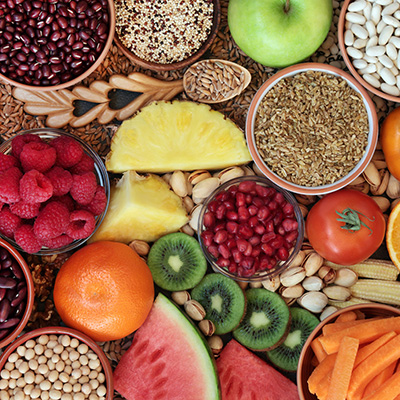Vitality eNews Sign Up
Receive the Summa Health eNewsletter for the latest health tips, advice and updates.
Let's Talk About Fiber!
Posted June 13, 2022 by Michelle Boltz, MS, RD, CSSD, LD

Fiber is found in fruits, vegetables, whole grains, legumes, and nuts. Fiber has many health benefits, including:
- Playing a role in lowering blood cholesterol
- Helping to control blood sugars
- Aiding in preventing constipation
- Contributing to weight management
According to the Institute of Medicine and USDA, women should aim for about 25 grams of fiber per day, and men should aim for about 38 grams per day, or it is recommended to have about 14 grams for every 1000 calories.
Types of Fiber
There are different types of fiber. Two types are insoluble and soluble fiber. Both are important to include as part of a daily meal plan.
Insoluble fiber does not dissolve in water. This is the structural part of the plant, such as the skin on the apple. Other types of insoluble fiber include: whole-wheat flour, wheat bran, nuts, beans and vegetables, such as cauliflower, green beans and potatoes. This type of fiber absorbs water and helps to prevent constipation.
Soluble fiber dissolves in water, forming a gel. Soluble fiber may be referred to as the glue that holds the plant together. An example of soluble fiber is the inside of the apple. Other sources of soluble fiber include: oats, peas, beans, citrus fruits, carrots, and barley. Soluble fiber aids in lowering cholesterol and stabilizing blood sugars.
With all of the health benefits of fiber, the question is, how does fiber fit into a diet when training and competing? As represented in the Position Statement from the Academy of Nutrition and Dietetics, Dietitians of Canada, and the American College of Sports Medicine, on Nutrition and Athletic Performance, while fiber is important for overall health, because fiber slows the emptying of the stomach, it is advisable to limit fiber during the 1-3 hours before exercise in order to avoid gastrointestinal (bathroom) issues on race day.
When not competing, if you want to increase your fiber intake, it is recommended to do so gradually, and include plenty of water. Because fiber absorbs water, if increased too quickly, and without adequate hydration, you could experience constipation.
It is recommended to increase fiber with foods before turning to supplements. Each fiber containing food provides a variety of other nutrients to the body, while supplements do not. Choose fruits, vegetables, whole grains, legumes and nuts. Keep in mind, the more processed a food is, the less fiber it contains. For example, for the same amount of calories, a whole apple has 4 grams of fiber and a ½ cup of apple juice does not contain any fiber. Remember to drink plenty of water as you increase that fiber!
